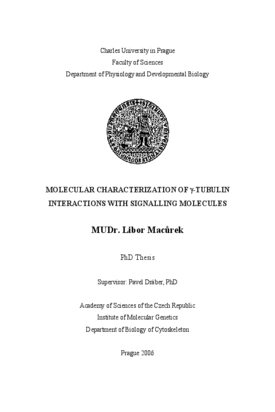Molecular characterization of γ -tubulin interactions with signalling molecules
Molekulární charakterizace interakcí γ -tubulinu se signálními molekulami
dizertační práce (OBHÁJENO)

Zobrazit/
Trvalý odkaz
http://hdl.handle.net/20.500.11956/95155Identifikátory
SIS: 112297
Katalog UK: 990009419350106986
Kolekce
- Kvalifikační práce [21483]
Autor
Vedoucí práce
Oponent práce
Binarová, Pavla
Svoboda, Augustin
Fakulta / součást
Přírodovědecká fakulta
Obor
Vývojová biologie
Katedra / ústav / klinika
Katedra fyziol. živočichů a vývoj. biol. (zrušena)
Datum obhajoby
15. 3. 2007
Nakladatel
Univerzita Karlova, Přírodovědecká fakultaJazyk
Angličtina
Známka
Prospěl
52 V. CONCLUSIONS The results of presented PhD thesis can be summarized as follows: For the first time it has been demonstrated that γ-tubulin forms complexes with αβ-tubulin dimers in brain tissue as well as in other models of neuronal differentiation. Two forms of γ- tubulin have been identified in complexes of various sizes. It has been shown that γ-tubulin is posttranslationally modified. One of the identified posttranslational modifications of γ-tubulin is phosphorylation that appears to depend on Src family kinase activity. It has been proposed that posttranslational modifications of γ-tubulin may regulate interactions of γ-tubulin with αβ-tubulin heterodimers or other associated proteins during neurogenesis. It has been shown that γ-tubulin associates with protein tyrosine kinases involved in signal transduction events. γ-Tubulin interaction with Src family kinases significantly increased after long-term RA-activation embryonal carcinoma P19 cells. A similar increase has been observed after rapid activation of mast cells, indicating that this regulatory mechanism is not restricted to a particular model system. In both models, Src family kinases bound to γ-tubulin are active and phosphorylate proteins present in γ-tubulin complexes. Fyn kinase interacts with γ-tubulin through its SH2 domain in a...
52 V. CONCLUSIONS The results of presented PhD thesis can be summarized as follows: For the first time it has been demonstrated that γ-tubulin forms complexes with αβ-tubulin dimers in brain tissue as well as in other models of neuronal differentiation. Two forms of γ- tubulin have been identified in complexes of various sizes. It has been shown that γ-tubulin is posttranslationally modified. One of the identified posttranslational modifications of γ-tubulin is phosphorylation that appears to depend on Src family kinase activity. It has been proposed that posttranslational modifications of γ-tubulin may regulate interactions of γ-tubulin with αβ-tubulin heterodimers or other associated proteins during neurogenesis. It has been shown that γ-tubulin associates with protein tyrosine kinases involved in signal transduction events. γ-Tubulin interaction with Src family kinases significantly increased after long-term RA-activation embryonal carcinoma P19 cells. A similar increase has been observed after rapid activation of mast cells, indicating that this regulatory mechanism is not restricted to a particular model system. In both models, Src family kinases bound to γ-tubulin are active and phosphorylate proteins present in γ-tubulin complexes. Fyn kinase interacts with γ-tubulin through its SH2 domain in a...
